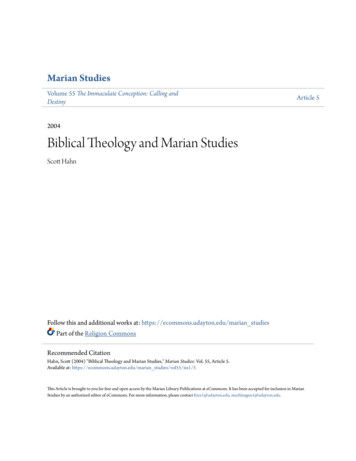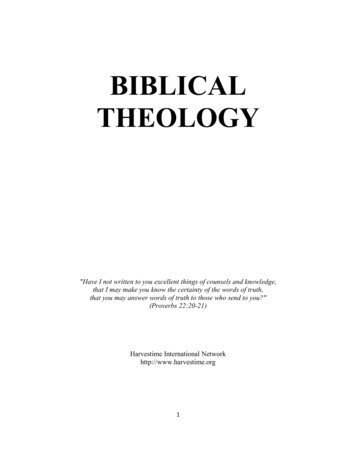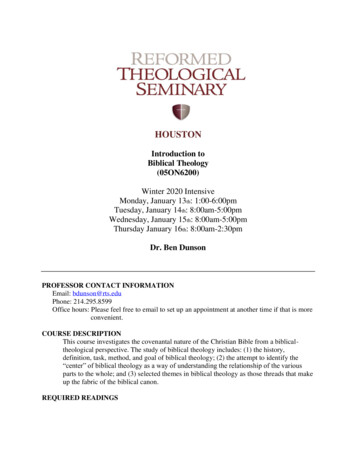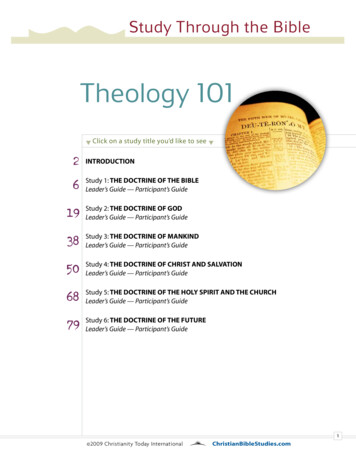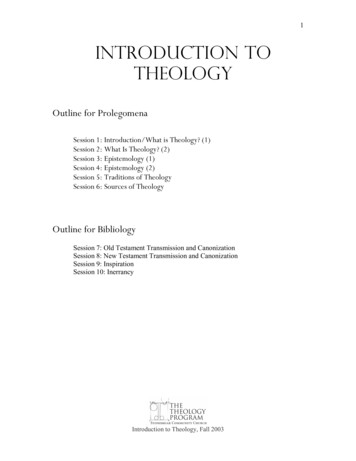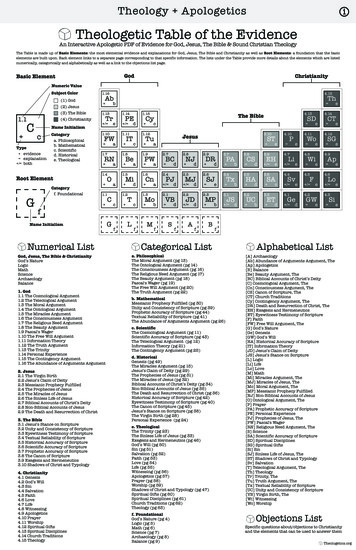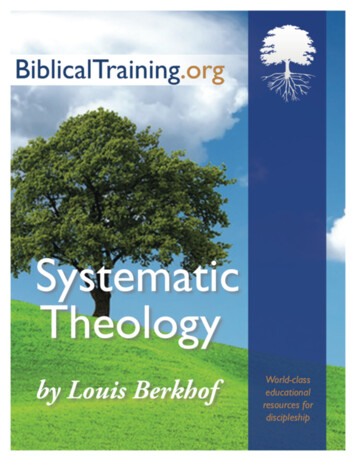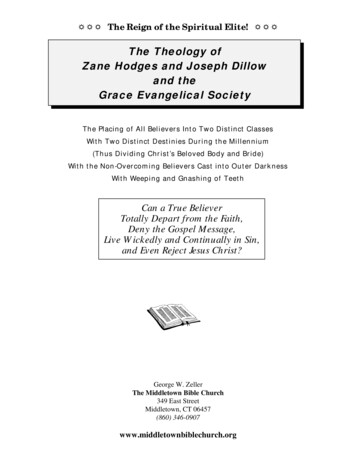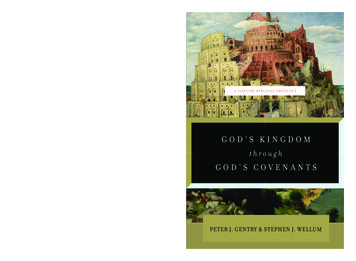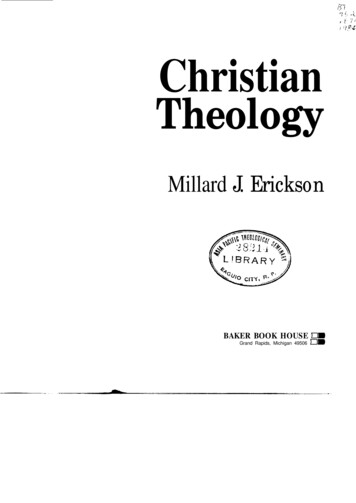
Transcription
The Biblical Theology of the ChurchEDMUND P. CLOWNEYEmeritus professor of practical theology and former president of Westminster Theological Seminary in Philadelphia,Pennsylvania.Do Christians need to think again about the doctrine of the church? Many would answer, 'No!'Mention the church and they begin to smell the musty odour of churchianity. It rises from thecrypts of institutional religion, and permeates the seat-cushions of formal traditions. MartinLuther thanked God that even a child of seven knows what the church is. 'Let the church focuson the gospel, preach Christ and him crucified, and the church will become part of the answerinstead of the problem'. That is the way Luther's point is often made today.Others would add that Luther's child of seven has had plenty of help in the last few years. If theteaching of the Bible about the church has been neglected in past centuries, that neglect hascertainly been more than remedied. Few cathedrals have been constructed in the last halfcentury, but theologians have launched a building boom of their own. The publishing skyline isfull of books about the church. [1]Not all of those books are theological, to be sure. Some writers assume that we cannot expectScripture to answer the problems of the computer age. The Apostle Paul did not have to faceMarxism nor deal with the problems of colonial exploitation and its aftermath. He was nottroubled with the internecine warfare of rival denominations and non-denominational agencies.Nor did he have to plant churches in a tribal cultural setting. He worked within his own cultureand could ordain as leaders, even in the Gentile churches, men who had been instructed in theScriptures as adherents of the Jewish synagogues. With such considerations the contemporaryecclesiastical pundit eases the Apostle to the Gentiles into his place back in the Hellenistic age.He is then free to display his own grasp of sociometrics, group dynamics, structuralistanthropology, and political hermeneutics. [2]It would be foolish, of course, to suggest that the behavioural sciences should be set overagainst Biblical understanding. In applying the teaching of God's Word, we must surelyunderstand as fully as we can the circumstances to which it is applied. Yet even in thatunderstanding, we seek to manifest the mind of Christ. Certainly we cannot begin ourunderstanding of the church with sociological analysis. We must begin with the teaching of theBible, and return to the Bible again and again to deepen and renew our understanding.Theology is reflective; we do understand God's revelation better as the context of our ownArticle published at The Biblical Theology Briefings – beginningwithmoses.org with permission. Page 1 of 50
experience widens and varies our perspective. But the church rests upon the foundation ofapostolic teaching. The authoritative words of the inspired witnesses chosen and endued of theSpirit communicate to us the full and final revelation of Jesus Christ (Acts 10:39-42; Heb. 2:2-4;Rev. 22:18, 19).The doctrine of the church is not the most fundamental doctrine of Scripture. J.C. Hoekendijkmay be right in saying, 'In history a keen ecclesiological interest has, almost without exception,been a sign of spiritual decadence.' [3] At the Third World Conference on Faith and Order heldin Lund in 1952 the conferees acknowledged: 'In our work we havebeen led to the convictionthat it is of decisive importance for the advance of ecumenical work that the doctrine of thechurch be treated in close relation both to the doctrine of Christ and to the doctrine of the HolySpirit'. [4]Indeed, the doctrine of the church is not only closely related to the doctrine of the Trinity, it flowsfrom it. The promise of God's covenant is, 'I will. be your God, and you will be my people' (Lev.26:12; 2 Cor. 6:16). God's people are his own possession, those whom he has formed forhimself that they might set forth his praise (Is. 43:21). The focus of Scripture is on the livingGod, of whom, through whom, and unto whom are all things, not least the people he hasredeemed and claimed as his own.It is not surprising, therefore, that the Biblical doctrine of the church is directly related to God'srevelation of himself. As we trace the history of redemption recorded in the Word of God, wefind that the church comes into view as the people of God, the disciples of Christ, and thefellowship of the Holy Spirit. Yet these views of the redeemed do not simply succeed oneanother; far less do they exclude one another. The Apostle Peter, writing to Gentile Christians inAsia Minor, calls them 'a chosen people, a royal priesthood, a holy nation, a people belonging toGod' (1 Pet. 2:9). To be sure, they were once 'not a people', but now they are 'the people ofGod' (v. 10). The language that described the calling of Israel in the Old Testament Peterapplies to the New Testament people of God. On the other hand, Christ is central for the OldTestament as well as for the New, and Paul, reflecting on the experience of Israel in thewilderness, affirms that 'the Rock that followed them was Christ' (1 Cor. 10:4). That sameleading of Israel through the desert is ascribed by the prophet Isaiah to the Holy Spirit (Is. 63:914).To gain the richness of biblical revelation, we do well to trace the unfolding of the theme of thechurch through the history of God's saving work. In doing so we are instructed by thetransformations of that theme as well as by the underlying unity of the purpose and work ofGod. To focus our consideration, we may reflect on the calling of the church. The church iscalled to God, called to be his people. By that relation to God the being of the church is defined.The church is also called, by that very relation, to a bond of life together. It ministers not only toGod, but also to those who make up its company. The church is also called in the midst of theworld. Its ministry is therefore threefold: it ministers to God in worship, to the saints in nurture,and to the world in witness.In systematic theology the doctrine of the church is often presented under the rubrics of theNicene Creed: the church is one, holy, catholic, and apostolic. Yet these attributes of the churchArticle published at The Biblical Theology Briefings – beginningwithmoses.org with permission. Page 2 of 50
flow from the more fundamental teaching of the Bible regarding the nature of the church as it isrelated to the Lord himself. Ecclesiology is part of theology. We gain the clearest light on theissues that the church now faces when we reflect on the calling of the church by the Father, theSon, and the Holy Spirit. This trinitarian approach to the doctrine of the church may then bestructured in relation to its calling to minister in worship, nurture, and witness.I. THE CHURCH AS THE PEOPLE OF GODA. God's Worshipping AssemblyMatthew's Gospel reports the words of blessing that Jesus spoke to Simon Peter in response toPeter's apostolic confession. Jesus then said, 'And I tell you that you arePeter, and on this rockI will build my church, and the gates of Hades will not overcome it' (Mt. 16:18). Matthew usesthe common term for 'church' in the New Testament, the termekklçs ia. It was once the habit ofcritics to question the authenticity of Matthew's report. Jesus spoke of the kingdom, and knewnothing of the church, they said. [5] Since the discovery of the Dead Sea Scrolls there hasbeen a belated acceptance of the genuineness of the saying. The scrolls are full of the conceptof the community, understood as the congregation of the saints awaiting the coming of the Lord.Further, the thought of the congregation being established upon the confession of the truth isalso prominent in the Dead Sea writings. [6] So is the figure of the rock, and of the buildingestablished upon it. [7] The parallels between the language of the Dead Sea sectaries and thewords of Jesus do not, however, indicate that Jesus was dependent upon the Essenes. Thebackground to both is the Old Testament.1. The People of God Constituted as God's AssemblyThe concept of the people of God as assembly has its Old Testament roots in the gathering ofIsrael before the Lord at Mount Sinai. God had demanded of Pharaoh, 'Let my people go, sothat they may worship me in the desert' (Ex. 7:16b). That service was to be a specific gatheringfor worship ('a feast unto me', Ex. 5:1). Of course there were further implications of thatdemand. Pharaoh regarded the Israelites as his slaves, subject to his own divine claims. Hislordship was directly challenged by God's claim. The worship, the service of the Lord on the partof Israel, would mark them as his people, his sons (Ex. 4:22, 23). It would be a covenantmaking ceremony in which the claim of God upon his people and the claim of the people uponGod would be ratified in worship.The term ekklçs ia describes an actual assembly, a gathering of people together. The same istrue of the Old Testament term qâhâl that is translated by ekklçs ia in the Septuagint version ofthe Old Testament. [8] The words themselves do not have the restricted meaning of our word,'church'. Yet, when Jesus said, 'I will build my church' (whether he spoke Greek, or used inAramaic a word that could be so translated), he was not simply saying, 'I will bring together agathering of people'. Rather, he was using a well-known term that described the people of God.The 'assembly in the desert' (Acts 7:38) was the definitive assembly for Israel, the covenantmaking assembly when God claimed his redeemed people as his own. In Deuteronomy it isArticle published at The Biblical Theology Briefings – beginningwithmoses.org with permission. Page 3 of 50
spoken of as 'the day of theassembly' (Dt. 4:10 LXX; 9:10; 10:4, 18:16).The key to the meaning of 'assembly' is found in God's command to Moses: 'Assemble thepeople before me to hear my words so that they may learn to revere me as long as they live inthe land and may teach them to their children' (Dt. 4:10). The assembly is a gathering to meetwith God. God declares, 'You yourselves have seen what I did to Egypt, and how I carried youon eagles' wings and brought you to myself' (Ex. 19:4). God's deliverance of Israel from Egypt isindeed an act of liberation. God strikes off their yoke and enables them to go upright (Lv. 26:13).But liberation from slavery in Egypt is not the final purpose of God's saving work. God bringsthem out that he might bring them in, in to his assembly, to the great company of those whostand before his face. The Lord who assembles the people to himself is the Lord of hosts. Hisheavenly assembly is composed of the mighty ones (’elohim), the holy ones (qedoshim), thesons of God (benei ha’elohim) over whom he reigns as King (Jb. 1:6; Ps. 82:1; 1 Ki. 22:19; Dn.7:10). When the Lord descends at Sinai, the tens of thousands of the heavenly holy ones areassembled with the congregation that is gathered at his feet (Dt. 33:2; Ps. 68:17). The earthlyassembly, too, is composed of the saints of the Lord (the same term can describe saints orangels). The Dead Sea community had a vivid awareness of this Old Testament panorama.Those who were added to the community became members of God's eternal assembly. Theygained a place with the holy angels (1QS 2:25; 11:7-9; lQH 3:21; 11:11, 12).God's assembly at Sinai is therefore the immediate goal of the exodus. God brings his peopleinto his presence that they might hear his voice and worship him. 'I am the Lord your God,whobrought you out of the land of Egypt, out of the land of slavery. You shall have no other godsbefore me' (Ex. 20:2, 3). Standing in the assembly of the Lord, hearing his voice, the peoplegain their identity from the self-identification of the Lord.Later AssembliesThe assembly at Sinai could not remain forever in session, however. It was succeeded by othercovenant-making assemblies. Deuteronomy, the second giving of the law, provides the accountof the renewing of the covenant in another great assembly before the death of Moses. WhenJoshua brought the people into the land, he convened a great assembly between Mount Ebaland Mount Gerizim, and read the blessings and curses of the covenant from the law (Jos. 8:34,35). David convoked an assembly to secure the succession of Solomon (1 Ch. 28:2, 8; 29:10,20). Jehoshaphat, Joash, and Hezekiah summoned assemblies of covenant renewal (2 Ch.20:5, 14; 23:3; 29:23-32; 30:2-25).After the exile, the great assembly under Ezra and Nehemiah was gathered to hear the Word ofGod (Ne. 8). This assembly was regarded in later times as the prototype of the synagogue. Thereading of the law in the synagogues and the prayers that were offered found their precedent inthis post-exilic assembly.In addition to these assemblies of renewal on historic occasions, there were other assemblies ofIsrael. The law required that the people gather three times a year at the appointed place ofworship (Lv. 23). These were festival assemblies: the Passover, Pentecost, and the Feast ofArticle published at The Biblical Theology Briefings – beginningwithmoses.org with permission. Page 4 of 50
Tabernacles. At this last feast every seventh year the law was to be read and the covenantrenewed (Dt. 31:9-13).To be a member of the people of God was to have the privilege of standing in the greatassembly before his face. To be sure, worshipping Israelites could rejoice in fellowship with oneanother as they assembled together. They could sing, 'How good and pleasant it is whenbrothers live together in unity!' (Ps. 133:1). But even that joy is a blessing that flows down fromabove, like the dew of Hermon, or the ointment running down the beard of the high priest (Ps.133:2, 3). Israel is bound together as a kingdom of priests, a holy nation (Ex. 19:6). Israelitesare a nation formed for worship, called to assemble in the courts of the Lord, and to praisetogether the name of the Most High.The Future Festival PromisedIsrael failed woefully in this priestly calling. The unity of worship was broken when Jeroboam setup the image of a calf at Bethel to bar the pilgrimage of the northern tribes to worship atJerusalem. In the temple at Jerusalem, the whole purpose of the assembly was shattered byidolatry. And so in judgment God scattered the people in exile; yet he did not forget his calling toa priestly nation. The prophets proclaimed a new assembly of the people of God. It would comein the glorious future when God would again manifest his presence. Isaiah pictures a greatfeast, spread on the mount of God, to which not only the remnant of Israel but also the remnantof the nations would be gathered in (Is. 2:2-4; 25:6-8; 49:22; 66:18-21; cf. Jer. 48:47; 49:6, 39).Zechariah sees a new Jerusalem, transformed into a holy city by the presence of the Lord (Zc.12:7-9; 13:1, 9; 14:7, 8, 16-21).Pentecost FulfilmentJesus promised that he would build his assembly by his death and resurrection. After he rosefrom the dead, he commanded his disciples to remain together in Jerusalem until they receivedthe promise of the Father, the gift of the Holy Spirit. That gift was poured out as they wereassembled together. It was at Pentecost, and the theme of the feast of Pentecost was fulfilled.Pentecost was the time of the first-fruits, the beginning of the great harvest of redemption. Peterpreached the fulfilment of the prophecy of Joel. The Spirit had been poured out, the worship ofthe new age had been ushered in. The church, the assembly for worship, was praising God.The great eschatological feast had begun. Jesus in his parables had spoken of the feastprepared, and of his mission as the Servant of the Lord to call to heaven's feast the host of poorand. broken sinners who filled the byways of the earth (Lk. 14:15-24). Now the ingathering hadbegun.The gospel call is a call to worship, to turn from sin and call upon the name of the Lord. It is noaccident that the New Testament church is formed by the coming of God the Spirit in the midstof an assembly gathered in praise. The church in any city is composed of those who 'call uponthe name of the Lord' in that place (Acts 9:14; 1 Cor. 1:2). Peter writes that the church is thepeople for God's own possession, 'that you may declare the praises of him who called you outof darkness into his wonderful light' (1 Pet. 2:9).Article published at The Biblical Theology Briefings – beginningwithmoses.org with permission. Page 5 of 50
The Assembly on Mount ZionThe picture of the church as a worshipping assembly is nowhere more powerfully presentedthan by the author of the Epistle to the Hebrews (ch. 12:18-29). He contrasts the worship of Godat Mount Sinai with the worship of the New Covenant. The worship at Sinai was anoverwhelming experience. Even Moses said, 'I am trembling with fear' (v.21). Yet the fear ofMoses was inspired by merely physical phenomena - a fire that could be touched (v.18). In contrast, the church of the New Covenant comes to the full reality: 'our God is a consuming fire'. IfMoses feared the earthly manifestation of God's presence, how much more should we be filledwith reverence and awe? We do not come to Mount Sinai in our worship, but to Mount Zion.That Zion is not the earthly, but the heavenly Zion, the sanctuary of the eternal city of God. Forthe author of Hebrews, this is not a figurative way of speaking. The heavenly Jerusalem is not aPlatonic abstraction. It is as real as the living God, as real as the risen body of Jesus Christ. Inour worship in Christ's church we approach thethrone of God the Judge of all. We enter thefestival assembly of the saints and the angels. We gather in spirit with the spirits of just menmade perfect. We enter the assembly of glory through Christ our Mediator, and the blood of hisatoning death. For that reason we must hear and heed the word of the Lord, and 'worship Godacceptably with reverence and awe' (v.28).Just as the great assembly at Sinai defined the covenant people of the Old Testament, so doesthe heavenly assembly define the church of the New Covenant. The principle is the same, thesaving purpose of God is the same. Moses and the other heroes of faith described in Hebrews11 are among the 'spirits of righteous men made perfect' who gather with us in the heavenlyassembly. Yet they without us could not be made perfect (Heb. 11:40). We now enjoy with themthe worship for which they longed by faith.Does the tremendous reality of that heavenly worship make our earthly behaviour irrelevant?Can we think, 'Since nothing can stop the heavenlyhallelujahs, our feeble little gatherings onearth are of no consequence'? That argument has often been advanced. 'Since the churchinvisible is one, earthly divisions are not too serious.' 'Since the heavenly church is holy, weneed not worry much about either personal holiness or church discipline.'The author of Hebrews draws the opposite conclusion. Precisely because we do approach theheavenly assembly in worship, we are not to forsake the assembling of ourselves together(Heb. 10:25). Precisely because we have the faithful promise of the city of God, we are toprovoke one another to love and good works (Heb. 10:24).Reverent corporate worship, then, is not optional for the church of God. It is not a form of groupbehavior to be accepted just because of its long tradition or its acceptability in many cultures.Rather, it brings to expression the very being of the church. It manifests on earth the reality ofthe heavenly assembly. The glory of God is that to which and for which the church is called.Article published at The Biblical Theology Briefings – beginningwithmoses.org with permission. Page 6 of 50
The Word in WorshipWe may not lose sight, either, of the importance of God's Word in the assembly of worship. Thedescription of the heavenly assembly in Hebrews 12 comes to a focus in the admonition to hearhim who speaks. God spoke from Sinai; the worship of the people responded to the Word of theLord. In the assemblies of the new covenant, the Word of God is no less central. God is not onlypresent in the midst of his people. He speaks. The ministry of the Word of God in worshippartakes of the solemnity of the occasion. Solemnity does not mean joylessness, for the Wordcalls to praise. Yet the authority of the Word of the Lord remains central for Christian worship.This is the Word of him who speaks from heaven (Heb. 12:25). God spoke in many differentways to the fathers through the prophets, but now he has spoken finally and conclusivelythrough his own Son. It is that word of the Lord that 'was confirmed to us by those who heardhim. God also testified to it by signs, wonders and various miracles, and gifts of the Holy Spiritdistributed according to his will' (Heb. 2:3, 4).Multi-level AssemblingAnother consequence of the definition of the church as a worshipping assembly is the extremeflexibility that the New Testament shows with respect to its use of the term 'church'. On the onehand, the term is applied to the church universal. This is the church which is the people of Godand the body of Christ without qualification (Mt. 16:18; 1 Pt. 2:9; Eph. 1:22,23). It is the churchas God alone can see it, the whole company of those who have been, are now, or ever will begathered to God in Christ. Some who perceive this New Testament concept have gone on todeny that any local gathering can be called in a full and proper sense the church. Such agathering may form a congregation of the church, no doubt, but the church by definition must bethe church universal. On the other hand, there are those who isolate what the New Testamentteaches about the local church. Paul does speak of the church at Corinth as the church ofChrist. In the book of Revelation, Jesus addresses letters to the seven churches in Asia Minor.Congregational theologians have therefore limited the church by definition to the localassembly. Anything beyond the local assembly, they say, should not be spoken of as thechurch, but as an association of churches. [9]In the New Testament, the question is further complicated by the fact that local churches arespoken of in more than one sense. At least, local churches come in surprisingly different sizes.The church in Laodicea is a city church, but apparently there was also in Laodicea a housechurch, meeting in the house of Nymphas (Col. 4:15). So, too, Paul can in one breath speak ofthe churches of Asia and of the church in the house of Aquila and Prisca (1 Cor. 16:19). TheWestminster Divines noted the house churches that existed along with city churches in the NewTestament and argued from this evidence for a presbyterian system of government. [10] Thecity church corresponded to the presbytery, and the house church to the local congregation.This line of reasoning recognized smaller and larger gatherings of the church, and furtherrecognized that one could exist within another. The presbytery, however, was a gathering of theministers and elders, not of the whole membership of the city church. Another differenceemerged from the development of congregational structure in the cities. Village churches wereArticle published at The Biblical Theology Briefings – beginningwithmoses.org with permission. Page 7 of 50
swallowed up in growing metropolitan areas. They became parish churches - gatherings of asize that was larger than the house church, surely, but perhaps smaller than some of the citychurches of the New Testament.We may ask, however, if the full flexibility of the New Testament view of the church isadequately recognized today. Because the church is defined by the heavenly assembly forworship, there is no one size of assembly on earth that is ideal or normative. Those who callupon the name of the Lord together may do so in larger or smaller assemblies. Such arecognition does not mean that smaller assemblies may be disorderly, or that assemblies at anylevel exist apart from the exercise of gifts of teaching, ruling, and diaconal service. But it doessuggest the possibility of fuller expressions of the worshipping assembly in large city gatherings,as well as the recognition of the important place of the house church, not as a rival form oforganization, but as an expression, in a more immediate setting, of the fellowship of those whocall upon the name of the Lord in one particular place.2. The Church as God's DwellingThe picture at Sinai of the people of God as a worshipping assembly is heightened by God'sprovision of the tabernacle. God not only met with the people as they were assembled beforehim. He also came to dwell among them. In the wilderness where they lived in tents, God'shouse would be a tent, too. When they entered the land and had fixed dwellings, God would puthis name in a place, and sanctify the temple of Solomon as his dwelling. The figure of thetabernacle made the presence of God more immediate and permanent.The immanence of God's presence with his people is a continuing theme in the Pentateuch.The Lord who walked in the garden of Eden to talk with Adam and Eve continues to address thepatriarchs in the land to which he called them. The altars that they built witnessed to thepresence of the Lord. This is particularly dramatic in the case of Jacob at Bethel, where Goddescends the stairway of Jacob's dream to repeat the sure promises of the covenant totheexiled patriarch. (Genesis 28:13 should be translated, 'And, behold, the LORD stood over him.'See Genesis 35:13, where the same preposition is used, 'Then God went up from him at theplace where he had talked with him'.) In the morning Jacob marvels at the presence of God:'Surely the LORD is in this place, and I was not aware of it. How awesome is this place! Thisis none other than the house of God; this is the gate of heaven' (Gn. 28:16, 17).How important for the people of God is the dwelling of God among them? Moses gives aneloquent answer in a time of crisis before the tabernacle was built in the wilderness. While hewas in the heights of Mount Sinai receiving the law of God and the plans for the tabernacle,Israel at the foot of the mountain committed idolatry before the golden calf. When Moses camedown from the mountain and was confronted with the sin of the people, God proposed anotherplan for his relation to Israel (Ex. 33:1-3). God was too holy and the people too sinful for God todwell among them. His presence was too great a threat. Surely, as the Holy One, he mustconsume them in a moment to remove their iniquity from his presence. God proposed,therefore, that the tabernacle not be built. God would not dwell in the midst. He would go beforeArticle published at The Biblical Theology Briefings – beginningwithmoses.org with permission. Page 8 of 50
Israel in the angel of his presence, drive out the Canaanites from the land, and give them theinheritance he had promised. But instead of living among them, he would meet with Moses in atent set up outside the camp (Ex. 33:7-11). The elaborate plans for the tabernacle would not benecessary, since God would not have his dwelling among the people.The reaction of Moses to that alternate plan shows how crucial the dwelling of God in the midstof Israel really is. Moses was distraught with grief. He mourned, and Israel mourned with him.Moses cried, 'If your Presence does not go with us, do not send us up from here!' (Ex. 33:15).God's presence among the people was the whole point of the exodus deliverance and of theinheritance of the land. Significantly, Moses prayed for God to reveal his glory. What Mosesasked was the very blessing that the alternate plan would have removed: the immediatepresence of the living God and the vision of his glory. God did appear to Moses, and proclaimedhis covenantal Name (Ex. 33:17-34:7). Although Moses was permitted to see only God's back,he did see the glory of the Lord. His request was granted. God did make his dwelling amongIsrael, and Moses could pray that God's presence in the midst would bring not swiftjudgment,but the forgiveness of sins. He could pray, too, that God would not simply give the people theirinheritance in Canaan, but that he would take the people as his inheritance, claiming them ashis own (Ex. 34:9).Moses' prayer was answered and the tabernacle was built. It symbolized both the threat ofGod's dwelling in the midst of Israel and the grace by which God's immediate presence waspossible. The tabernacle was a dwelling in which the presence of God was both screened offand revealed. The curtains of the holy of holies, of the holy place, and of the tabernacleenclosure screened off the Holy One from the camp of sinful Israel. The curtains insulated, as itwere, the holy presence of God. But the plan of the tabernacle also symbolized a way into theholiest place, an avenue to the throne of God. After the blood of atonement had been shed atthe sacrificial altar, the priest could wash at the laver, enter the holy place, and present theprayers of the people. Once each year, on the day of atonement, the high priest could entereven the holy of holies to sprinkle the ark of the covenant with blood.Christ the True TempleThe New Testament presents the fulfilment of this symbolism in Jesus Christ. He is Priest,Sacrifice, and Temple. 'Destroythis temple', he said, 'and in three days I will raise it up' (Jn.2:19). The temple that he spoke of was his own body. 'The Word became flesh and made hisdwelling among us. We have seen his glory, the glory of the One and Only, who came from theFather, full of grace and truth' (Jn. 1:14). The outward picture of God's dwelling among hispeople becomes a reality in the incarnation. [11] Further, since God is present in Christ, andChrist is present among his people, they, too, become a dwelling for God. Christ, who promisesto prepare a dwelling place for his disciples, promises also that both he and the Father willcome and take up their dwelling with the disciple that loves him (Jn. 14:2,23). Both the individualbeliever and the church are spoken of as the temple of God because of the presence
In systematic theology the doctrine of the church is often presented under the rubrics of the Nicene Creed: the church is one, holy, catholic, and apostolic. Yet these attributes of the church . Article publishe
